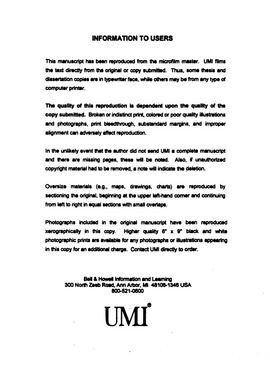| dc.contributor.advisor | White, Robert L., | en_US |
| dc.contributor.author | Bonnet, Edouard Francois Jean-vianney. | en_US |
| dc.date.accessioned | 2013-08-16T12:30:59Z | |
| dc.date.available | 2013-08-16T12:30:59Z | |
| dc.date.issued | 2000 | en_US |
| dc.identifier.uri | https://hdl.handle.net/11244/6003 | |
| dc.description.abstract | The work presented here describes the development of a fixed bed catalytic microreactor capable of repetitive injection gas chromatographic analysis of microreactor effluent. The design of our fixed bed microreactor incorporates new features that overcome common limitations. Short, heated lines ensure quick transfer of reactor effluents to the GC/MS analyzer. The GC small size (8 in. x 6 in. x 6 in.) allows for rapid heating and cooling. Consequently, fast repetitive separations can be achieved even when using GC oven temperature ramps. | en_US |
| dc.description.abstract | Research projects in Dr. White's laboratory involve heterogeneous catalysis. Catalytic reaction studies include two types of analysis. First, surface analysis characterizes the reactant-catalyst interactions and may be able to identify the nature of intermediate species formed at the catalyst surface. Second, volatile product analysis allows for qualitative and quantitative determination of the catalytic reaction products. A variable temperature diffuse reflectance Fourier transform infrared spectrophotometer and a thermal analyzer coupled with gas chromatography and mass spectroscopy were developed in the past for surface and volatile product analysis respectively. Reactants were either coated or adsorbed onto the catalyst at the beginning of an experiment. These instruments gave us an insight to catalytic systems. However, our studies were limited because they did not readily allow for the use of flowing reactants. | en_US |
| dc.description.abstract | The microreactor-GC/MS system was characterized by applying it to studies of known catalytic systems. Consequently, flaws in the design became apparent and improvements were made. The microreactor system was then used to study nickel aluminate, NiAl2O4, a potential oxidation catalyst. Results indicated that nickel aluminate has some activity for the oxidation of cellulose and n-butane. However, kinetic studies showed that its activity was far less than that of 1% Pt-Alumina. | en_US |
| dc.format.extent | xiv, 168 leaves : | en_US |
| dc.subject | Mass spectrometry. | en_US |
| dc.subject | Chemistry, Analytical. | en_US |
| dc.subject | Microreactors. | en_US |
| dc.subject | Heterogeneous catalysis. | en_US |
| dc.title | A fixed-bed catalytic microreactor with repetitive injection gas chromatographic/mass spectrometric analysis. | en_US |
| dc.type | Thesis | en_US |
| dc.thesis.degree | Ph.D. | en_US |
| dc.thesis.degreeDiscipline | Department of Chemistry and Biochemistry | en_US |
| dc.note | Adviser: Robert L. White. | en_US |
| dc.note | Source: Dissertation Abstracts International, Volume: 61-06, Section: B, page: 3039. | en_US |
| ou.identifier | (UMI)AAI9975806 | en_US |
| ou.group | College of Arts and Sciences::Department of Chemistry and Biochemistry | |
